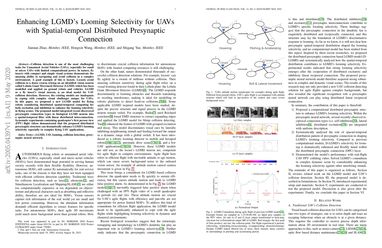Enhancing LGMD's Looming Selectivity for UAV with Spatial-temporal Distributed Presynaptic Connections
Collision detection is one of the most challenging tasks for Unmanned Aerial Vehicles (UAVs). This is especially true for small or micro UAVs, due to their limited computational power. In nature, flying insects with compact and simple visual systems demonstrate their remarkable ability to navigate and avoid collision in complex environments. A good example of this is provided by locusts. They can avoid collisions in a dense swarm through the activity of a motion based visual neuron called the Lobula Giant Movement Detector (LGMD). The defining feature of the LGMD neuron is its preference for looming. As a flying insect's visual neuron, LGMD is considered to be an ideal basis for building UAV's collision detecting system. However, existing LGMD models cannot distinguish looming clearly from other visual cues such as complex background movements caused by UAV agile flights. To address this issue, we proposed a new model implementing distributed spatial-temporal synaptic interactions, which is inspired by recent findings in locusts' synaptic morphology. We first introduced the locally distributed excitation to enhance the excitation caused by visual motion with preferred velocities. Then radially extending temporal latency for inhibition is incorporated to compete with the distributed excitation and selectively suppress the non-preferred visual motions. Systematic experiments have been conducted to verify the performance of the proposed model for UAV agile flights. The results have demonstrated that this new model enhances the looming selectivity in complex flying scenes considerably, and has potential to be implemented on embedded collision detection systems for small or micro UAVs.
PDF Abstract
